Employee engagement: measure it and grow it
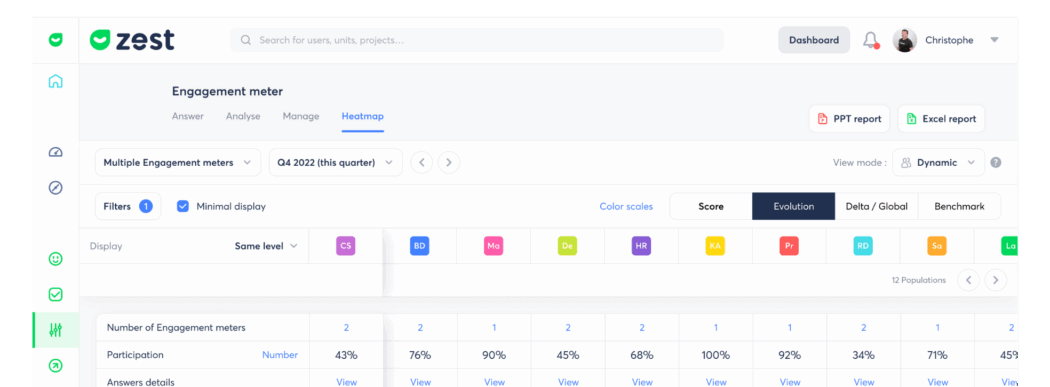
Meeting the psychological needs of your talent at work is a top priority at Zest!
According to ANDRH, employee engagement is defined as “all the actions taken by an employee that go beyond the basic requirements of their employment contract, reinforcing the feeling of contributing to a shared project while aligning with the company’s values” (Revue Personnel ANDRH, 2012). In short, it refers to the level of involvement, motivation, and commitment an individual has toward their organization, enabling them to achieve their goals and contribute to its overall success.
The concept emerged in the 1970s, initially linked to job satisfaction and long-term employee retention. It was first formally defined in 1990 by William Kahn, widely regarded as the founding father of employee engagement: “In engagement, people employ and express themselves physically, cognitively, and emotionally during role performances” (Academy of Management Journal).
Today, employee engagement is a true driver of performance. It is also a strategic retention lever for HR teams, executives, and managers. Engagement helps effectively address issues like turnover and absenteeism, which can be highly detrimental to team cohesion and overall success.
Employee engagement in France: where do we stand in 2025?
In France, the current trend is leaning toward disengagement, with:
- An engagement rate of just 7% (compared to 13% on average in Europe)
- A resignation intention rate of 23% within the next 12 months
- 1 in 3 employees feeling demotivated, and 38% of talent acting as detractors of their company
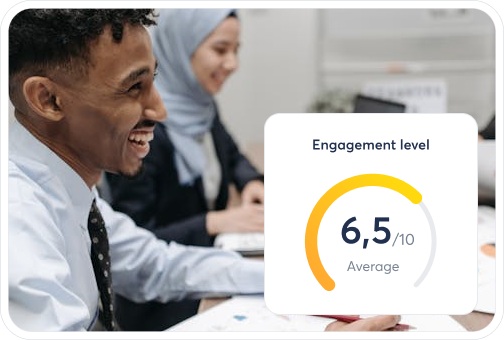
Employee Engagement Pyramid
Inspired by Maslow’s hierarchy of needs, the Employee Engagement Pyramid defines 12 engagement drivers grouped into 4 key dimensions.
1
Basic needs
Expectations and available resources.
2
Support and management
Achievement, recognition, appreciation, and development
3
Teamwork
Interest, appreciation, involvement, and sense of belonging
4
Growth
Encouragement and opportunities

The 3 categories of employee engagement
There are also 3 types of employee engagement:
- Emotional engagement: alignment with company values and strong personal commitment
- Normative engagement: a deep sense of duty and loyalty toward the employer
- Continuance engagement: involvement without real conviction, driven mainly by financial or job security concerns
Zest boosts your talent engagement to drive greater performance and success!
Employee engagement: why improve it?
Continuously improving employee engagement brings valuable individual and collective benefits to your organization.

Improved workplace well-being
Boosting employee engagement means creating a positive employee experience and fostering a company culture focused on quality of work life, health, safety, active listening, recognition, sense of belonging, growth and purpose at work. These are key employee expectations in 2025 and core drivers of well-being.

Reduced turnover
Meeting these expectations means creating a stimulating and fulfilling work environment. As a result, it leads to lower turnover rates and related costs (down 24% according to Gallup), reduced absenteeism (down 41%), and improved talent retention. This is a crucial factor in today’s competitive landscape marked by talent shortages and retention challenges.

Performance optimization
Employee engagement is also a powerful driver of performance and competitiveness. Highly engaged employees lead to increased productivity (up 17%) and profitability (up 21%) for the company. Actively engaged team members can generate a salary return of up to 120% (Human Capital Institute, 2010).

Strengthening the employer brand
Not to mention the positive impact of employee engagement on your employer brand. Remember, your people are your best ambassadors. Boosting employee engagement also means boosting your eNPS (Employee Net Promoter Score) and your ability to attract top talent.

Improved customer experience
Companies with high employee engagement see a 10% improvement in their customer experience. Engaged employees help create a culture of mutual care, encourage creativity, drive initiative, support problem-solving and foster innovation.
How can you improve the employee experience to maximize engagement?
- Understanding the importance of the employee experience to maximize engagement: The employee experience includes every moment lived at work and directly impacts engagement. A positive experience enhances overall company performance.
- Measure and assess the employee experience with tools like Zest’s Engageometer: Measuring the experience with tools like the Engageometer provides a complete diagnostic and helps track employee satisfaction at every key stage.
- Involve management to maximize employee engagement: 70% of engagement drivers are linked to management, which makes a collaborative action plan involving frontline managers essential.
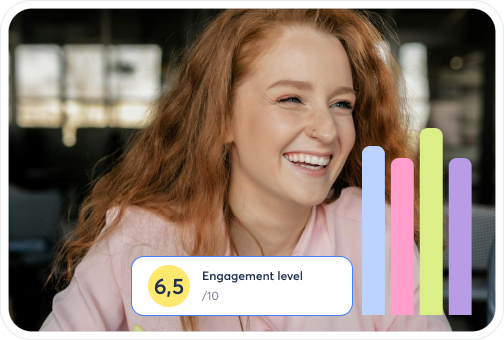
The 10 pillars of employee engagement
Here are 10 key employee engagement drivers. Each one is a powerful lever to activate in order to boost team involvement and performance :

Well-being at work and quality of work life (QWL)
Since 2020, the way we view work has shifted. Mental and physical health, safety, and quality of work life have become top priorities for both individuals and organizations. Practice active listening, identify employee expectations, feelings and early warning signs. Then analyze the insights and take meaningful action to reduce psychosocial risks and turnover.
👉 In Zest: use the Listen pillar

Purpose
Or sense of meaning at work: employees need to clearly understand how their role contributes to the company’s strategy and success. Strengthen motivation and engagement by providing fulfilling and meaningful work content.
👉 In Zest: use the full suite (all pillars)

Mission and objectives
Autonomy, initiative, and participation are powerful engagement drivers that should be actively encouraged. Set clear, specific, and ambitious goals that are built collaboratively.
👉 In Zest: use the Perform pillar


Recognition
Recognizing work such as progress, ideas and individual contributions relies on a company culture that encourages feedback and celebrates both big and small wins. It is a powerful driver of engagement.
👉 In Zest: use the Share pillar

Skills development
Training, career growth and support are key. In a BANI world (Brittle, Anxious, Nonlinear and Incomprehensible), employees place high value on opportunities to grow in their professional journey. Recognize their potential and actively support their skill development.
👉 In Zest: use the Perform pillar

The relationship with the manager
The manager plays a key role in driving engagement. They convey the company’s vision and guide their teams as a coach-leader. Encourage the development of an engaging leadership style built on active listening, constructive dialogue and transparency.
👉 In Zest: use the Perform pillar

Peer relationships
Strong interpersonal relationships and a sense of belonging at work are essential for effective collaboration, open communication, innovation and creativity.
👉 In Zest: use the full suite (all pillars)

Company culture
Company culture plays a central role. Regularly communicate your mission, values, commitments and company vision to engage and unite your teams.
👉 In Zest: use the Share pillar
Employee engagement: how to measure it?
Are your employees engaged, not engaged or disengaged? The good news is that engagement levels can be measured. This allows you to make better decisions and take meaningful action.
1
Which HR metrics should you track to measure employee engagement?
Among the most relevant KPIs for measuring employee engagement, pay close attention to the following:
👉 absenteeism rate, which reflects low motivation and poor quality of work life
👉 turnover rate, which indicates how well you retain your talent
👉 post-probation hiring rate, a sign of the quality of your onboarding process
👉 eNPS, which measures employee satisfaction and loyalty
2
Implement concrete actions to boost employee engagement
It’s time to build your action plan, take initiative, and communicate your efforts so they have a real impact.
Focus on planning your top corrective actions and engage frontline managers—they are a key asset. Don’t forget to highlight your strengths as well.
3
Conduct an internal survey
Ask your employees about key engagement pillars such as company culture, well-being, recognition, interpersonal relationships, skill development, feedback, purpose and more.
4
Identify the drivers of employee engagement
Modernize your employee listening system by collecting real-time feedback on a continuous basis. Identify their key motivation drivers, needs and expectations to boost engagement from day one.
The Zest advantage: 360° features including the Engageometer, surveys, motivation drivers, and Pulse or 360 feedback
5
Analyze the survey data
Finally, analyze the collected data to identify strengths, areas for improvement and valuable ideas within your organization.
How can you improve your employee engagement?

Optimize your onboarding process
It is essential to deliver a high-quality welcome experience for new talent from day one, by offering a smooth, successful and frictionless onboarding journey.

Encourage feedback and recognition
Share regular and constructive feedback with your teams about their work, efforts and key areas for improvement. A strong feedback culture and open dialogue are powerful drivers of employee engagement.

Reward your most engaged employees
A strong marker of recognition for their involvement and individual contributions beyond their objectives. This strengthens their sense of belonging, boosts retention and turns them into true ambassadors.

Support work-life balance with greater flexibility
Thriving at work, yes, but not at the expense of personal life. Since 2020, this has become a top priority for employees. 95% of workers say it is essential for their organization to respect the boundaries between their professional and personal lives (American Psychological Association, 2023). This highlights the need for meaningful cultural change supported by greater flexibility.

Offer growth opportunities
Provide your employees with personalized support tailored to their skills and expectations. Focus on offering career development opportunities and engaging talent programs. In fact, 41% of employees stay longer with employers who invest in internal development (LinkedIn study, 2020).

Strengthen your QWL strategy (Quality of Work Life)
QWL is a key source of well-being and fulfillment at work for your talent, and therefore a driver of performance for your company. Training, work-life balance, employee experience, autonomy, workplace experience, positive interpersonal relationships, supportive management, health and safety are all essential engagement factors.

Make training and skill development more accessible
Similarly, 94% of employees say they would stay longer if their company invested in training opportunities (LinkedIn study, 2019). This shows how crucial a strong learning experience and talent development programs are for maximizing engagement and retention.

Align company culture and values
A strong and shared company culture directly boosts employee engagement. This culture forms the DNA of your organization, makes it unique, and is reflected in your values, behaviors and operating norms.

Create moments of connection and team bonding
Workplace conviviality is also essential. It refers to shared social moments and informal interactions. It helps build interpersonal relationships, encourages open communication and strengthens team collaboration. In short, it is a real driver of engagement, individual well-being and collective performance.

Prevent psychosocial risks (PSRs)
Just as stress and burnout can lead to employee disengagement, preventing psychosocial risks and identifying early warning signs in time can help reengage your teams. This requires a company culture centered on care and well-being.

Recognize individual initiatives
Recognition affirms each person’s value and their sense of belonging to the team. Highlight your employees’ initiatives to boost their self-esteem, support motivation at work and give greater meaning to their role within the company.

Involve employees in key decisions
Seek input from your employees when making major decisions. Foster a collaborative and inspiring culture where your people innovate, share ideas, take initiatives that have a positive impact on the company and contribute to strategic decision-making.
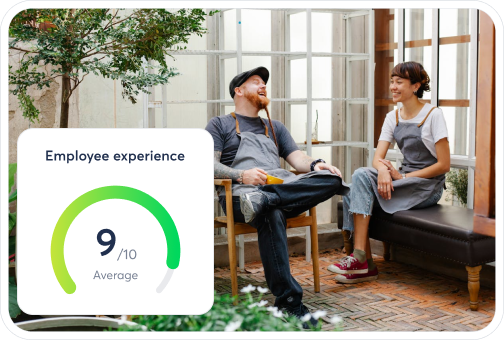
Best practices for a successful employee engagement survey!
- Set clear objectives: measure engagement and guide strategic actions.
- Ask relevant questions: include key indicators and keep the survey to a maximum of 30 questions.
- Maintain the right frequency: biannual or annual to avoid survey fatigue.
- Supplement with additional tools: Pulse surveys for regular monitoring and one-on-one check-ins for individual insights.
- Leverage the results: turn insights into concrete actions and track their impact.
5 secrets to sustaining employee engagement tracking
Check the pulse continuously. Regularly assess employee engagement levels and how they evolve over time. Management Tech can support you in this process, especially through the use of an HR platform. Here are five practical best practices to guide you.
1
Conduct regular engagement surveys
Keep regularly checking in on how your teams feel about how the company is operating, whether on a general level or regarding more specific topics. Engagement survey are valuable diagnostic tools. They rely on both qualitative and quantitative HR indicators, such as well-being and job satisfaction, engagement levels, employee experience and turnover rate.
In the Zest digital suite, you can launch a custom engagement survey or use our Engageometer, designed by our QWL experts, to benefit from our benchmark data.
2
Create surveys on specific topics
Pulse Surveys are a great complement to the annual engagement survey and an excellent way to continuously listen to employees. In Zest, targeted surveys can be launched on specific topics such as onboarding, company culture, CSR engagement, internal communication or HR initiatives.
3
Implement measurable concrete actions
Surveys and engagement assessments should never be left without follow-up. On the contrary, they must lead to concrete action.
In Zest, you can launch action plans based on areas for improvement identified through our Engageometer and its 18 motivation drivers, designed by a PhD in psychometrics. This turnkey and customizable survey helps you measure and understand what truly matters to your employees, your real engagement drivers.
4
Request feedback on the actions implemented
Don’t forget, as part of a continuous improvement approach, to request feedback on the actions taken. This allows you to adjust your action plan if needed, based on the feedback received.
5
Communicate the success (or failure) of the actions implemented
Transparency and communication are key to engagement and success. In Zest, you can customize access to results by team, department or location. Sharing the results creates an opportunity to openly discuss solutions to the challenges raised, as well as the successes or setbacks of the actions taken.
Zest is a 360° digital solution designed to effectively measure, understand and manage employee engagement. With Zest, you can regularly and precisely track your team’s engagement level and how it evolves over time. Launching a survey is quick and intuitive, either by using a ready-made engagement survey template or by creating a fully customized version based on your specific needs.
Zest is the most complete, modular and configurable app on the market. Launch your engagement survey once or set it to recur weekly, monthly, bi-monthly or quarterly. This ensures effective tracking and long-term improvement of engagement across your organization.
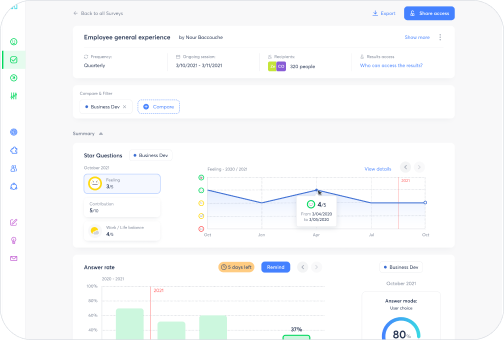
FAQ
Do you have any questions?
Employee engagement is a shared responsibility across the organization. The main stakeholders involved are:
– Managers: They play a key role by communicating thoughtfully and actively supporting engagement initiatives.
– Human Resources: They design and implement company-wide engagement strategies.
– Leadership: They shape the company culture and values, which are essential to fostering engagement.
– Employees themselves: They take an active role in engagement efforts and provide valuable feedback.
Using employee engagement software offers several advantages:
– Improved internal communication
– Optimization of the onboarding process for new employees
– Reduced attrition rate
– Increased productivity
– Centralization of HR functions
– Real-time feedback collection and analysis
Employee engagement can be measured in several ways, but the most common method is through engagement surveys. Here are the general steps:
1. Conduct regular surveys (annually or more frequently)
2. Analyze the results by identifying key engagement drivers
3. Calculate an overall engagement score based on the responses
There is no single formula, but one common approach is to calculate the average score from key engagement-related questions.
The employee lifecycle includes all stages of the relationship between an employee and their company. It typically consists of seven phases:
Attraction ; Recruitment ; Onboarding
; Retention ; Development ; Offboarding ; Alumni
More Zest news

Mastering the professional development interview: key strategies and best practices

fixed-term contracts and annual reviews: 5 keys to a successful evaluation











